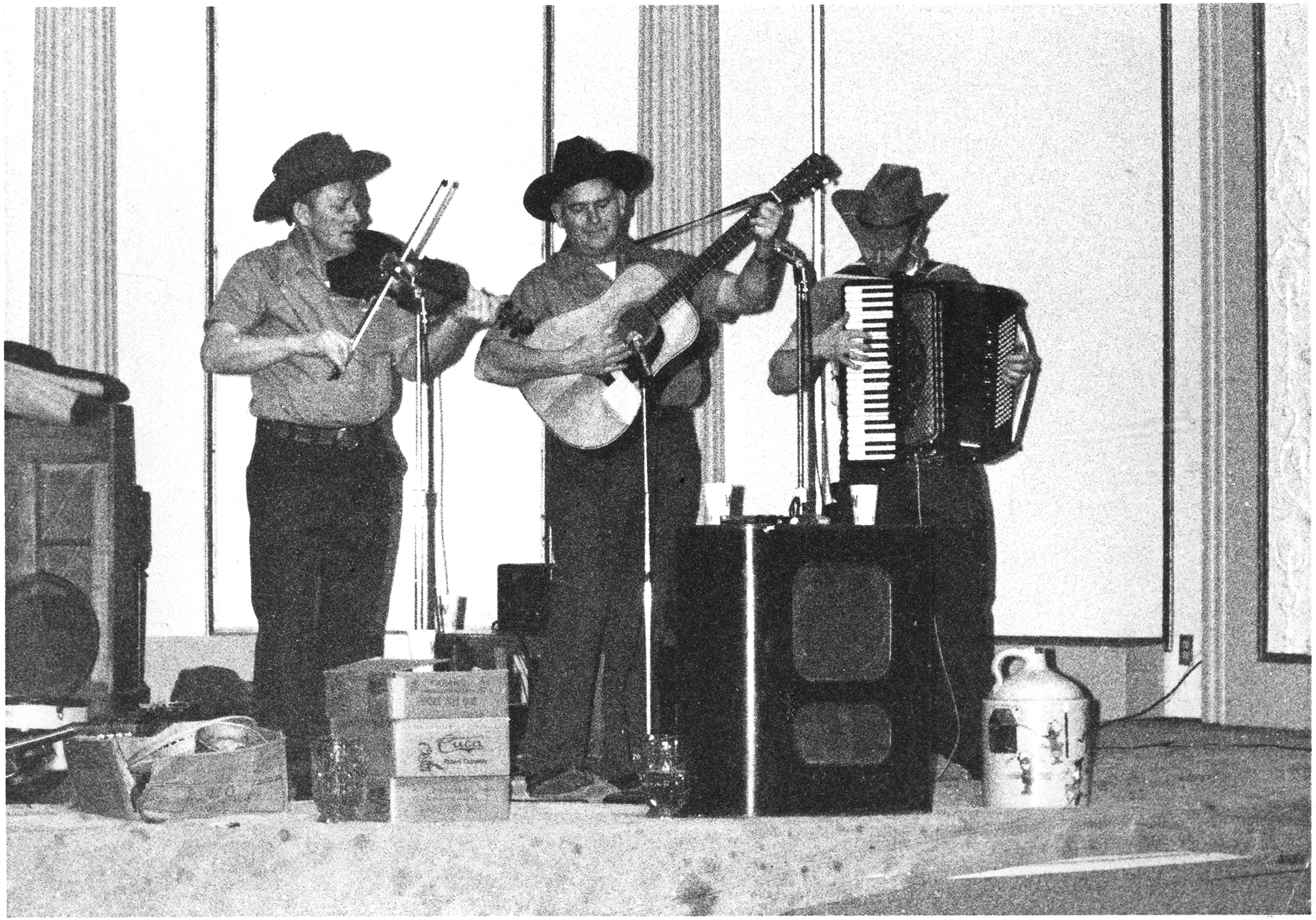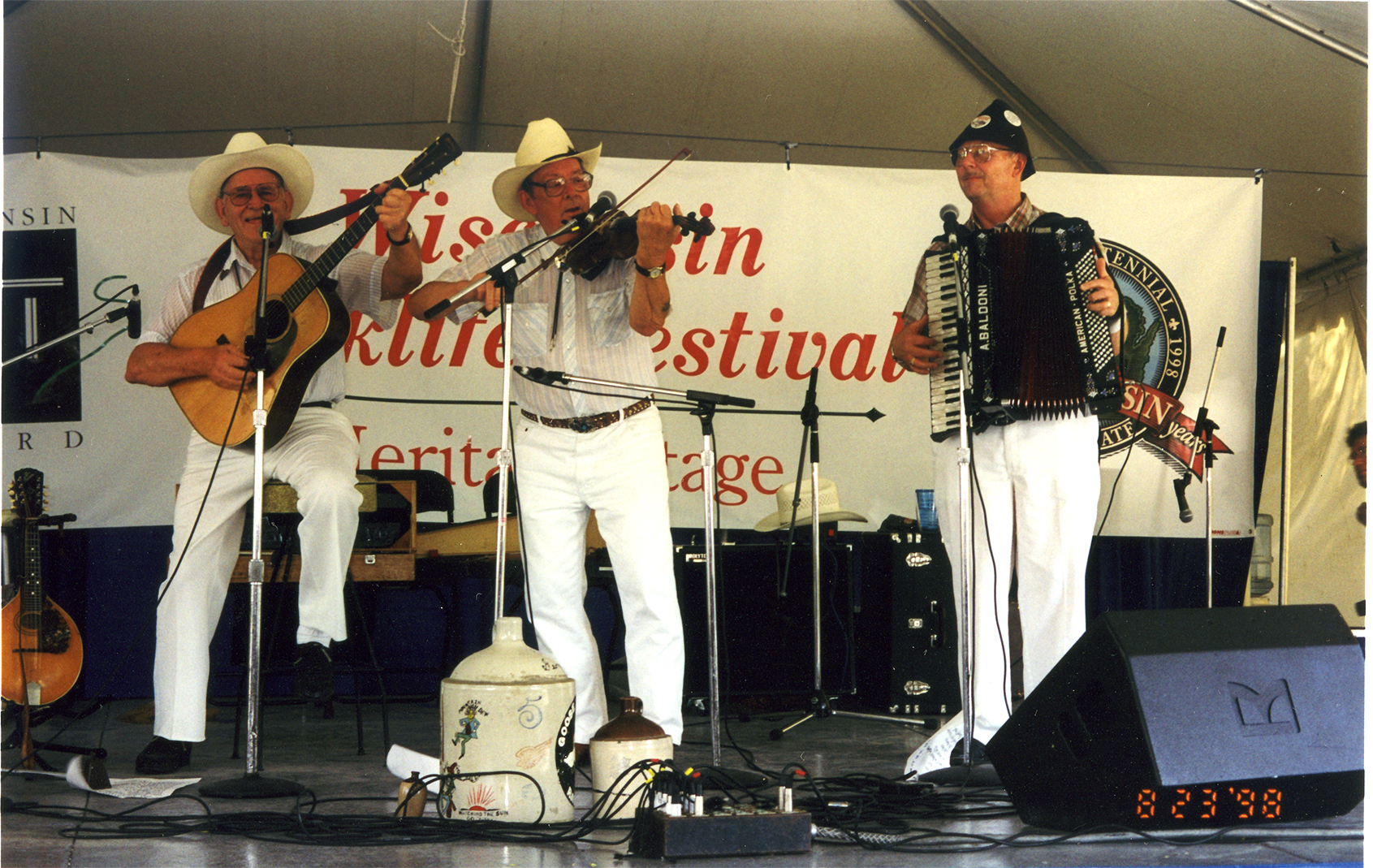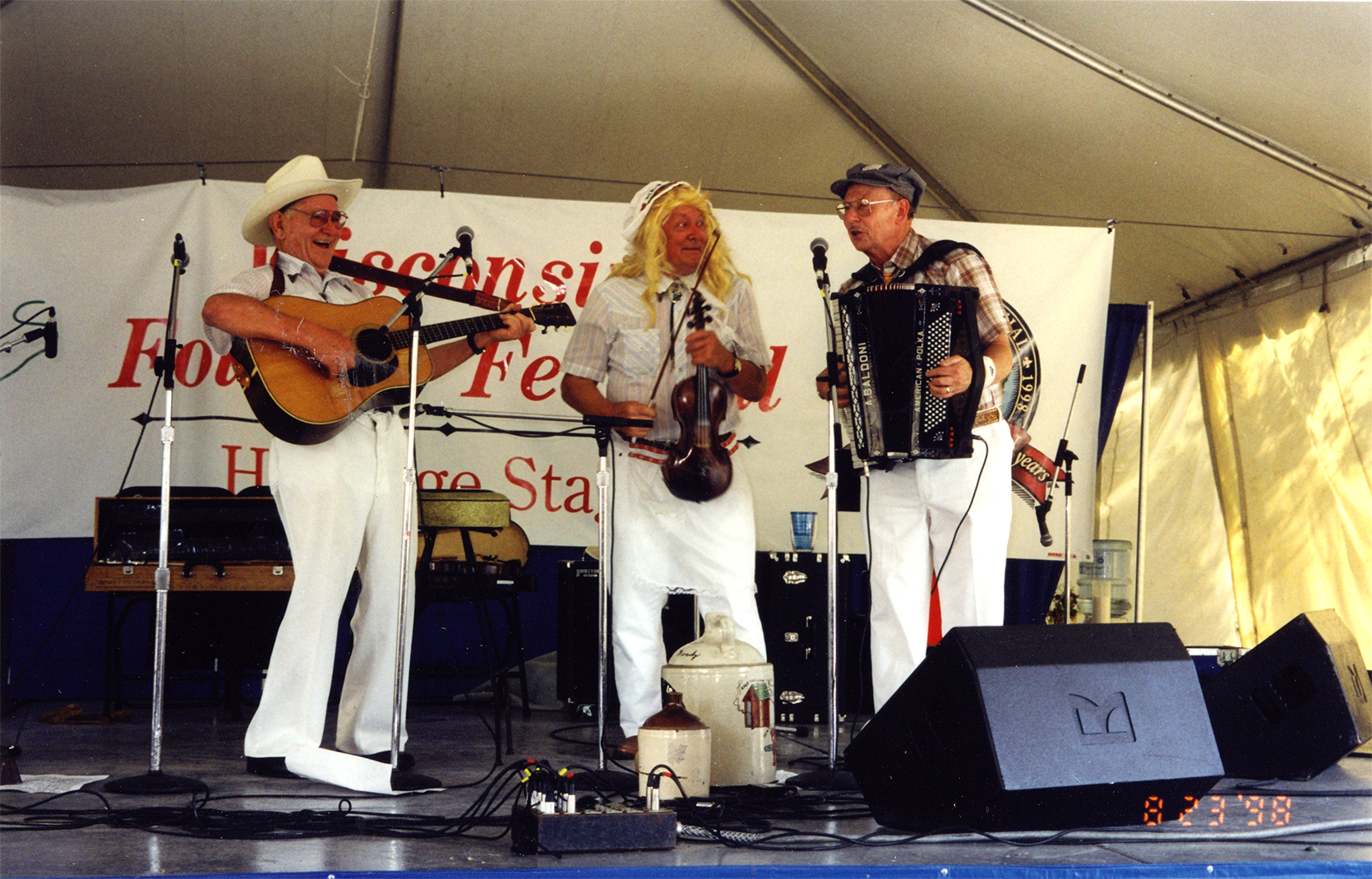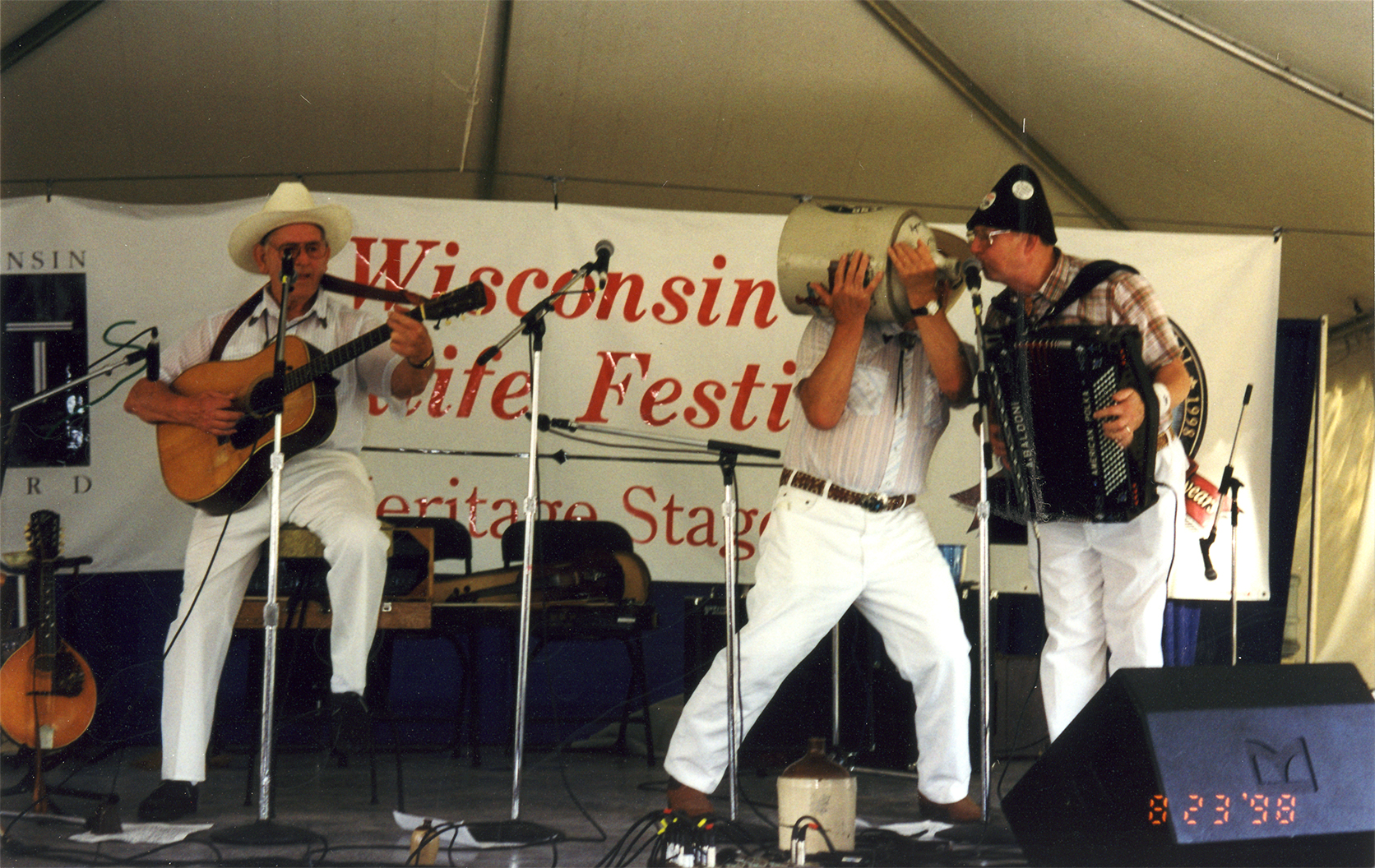
I don’t think I can begin to describe how much The Goose Island Ramblers and their music have meant to me over the years. Nor can I say how strongly they influenced me as a musican and a performer or how much incredible music they taught me. I still learn things every time I listen to one of their recordings. As I listen I’m struck by how much love shines through on their recordings, for the music itself, for each other, and for their audience. Most of all I remember the incredible fun they generated whenever they performed.
I first heard The Goose Island Ramblers in the early 1970s in Madison, WI, my hometown. I was attending the University of Wisconsin at the time and started going to see The Goose Island Ramblers at Johnny’s Packer Inn, a workingman’s bar on Madison’s east side, not far from the Oscar Mayer packing plant. One of the trio, guitarist, fiddler, and singer Wendy Whitford worked nearly his entire adult life at Oscar’s. Wendy, also known as “Windy,” wrote a locally well-known song called “Oscar’s Cannonball” during World War II about the powerful and fast train, “Oscar’s Cannonball,” that brought livestock to the factory and aided the war effort.
The other two members of the band were George Gilbertsen, who played just about every stringed instrument from fiddle to dobro to mandolin to several non-stringed instruments like harmonica, and Bruce Bollerud, on accordion, bandonion, other button and keyboard instruments, and jug.
The Geese played at least once a week at Johnny’s Packer Inn during my college years. My time at the bar was well-spent learning an incredibly broad repertoire of country, bluegrass, old-time, cowboy, fiddle, German, Norwegian, Swiss, Polish, western, swing, pop, music. Again, that list doesn’t really cover the range or depth of the music they offered.
Most often, when I think of Wendy, George, and Bruce, I remember the light-hearted way they delivered their music. They expressed a range of emotions, feels, and grooves but you got the feeling that they didn’t take themselves or any of the performing hoo-hah very seriously. They always exuded the feeling that they loved doing what they were doing and felt honored, maybe even blessed, to be able to get together with friends, hoist a few, and make music.

I got to be friends with Wendy, George, and Bruce, and interviewed them for a paper I wrote on local folk music during my senior year in college. After graduation and my move to the west coast I kept in touch and we’d always get together for a jam or party when I’d get back to town for a visit. They always had three or four or five new songs to play, often old Norwegian fiddle tunes which Bruce referred to as “Norwegian House Party Tunes.” (I eventually helped Bruce collect a number of these tunes into his “Accordion Uff Da! Let’s Dance: Scandinavian Fiddle Tunes & House Party Music”. I adapted his accordion book for mandolin: “Mandolin Uff Da! Let’s Dance: Scandinavian Fiddle Tunes & House Party Music.” The Goose Island Ramblers were an inexhaustable fount of new music, at least music new to me. As I mentioned above, it would be impossible for me to catalog all that I’ve gotten from Wendy, George, and Bruce. I think of it as a great gift that I treasure and draw from continually as I grow as a musician.
Of course times have moved on since the early 1970s. Wendy, George, and Bruce are all gone now. Their memories remain and their music lives on. It’s wonderful that we can still enjoy it.

Wendy Whitford played a mid-1940s Martin Herringbone D-28 guitar. He got it new as a gift from his wife Helen. I have probably heard this guitar played more in my life than any other. Countless hours watching The Geese play live and many, many more listening to their recordings. By the time I first saw and heard the guitar in the early 1970s it had already been well- played. Wendy treasured the guitar and had it with him on every musical occasion, whether strumming it in his living room or backyard, on a concert stage, in a dance hall, or in a bar. He probably didn’t take it fishing or to bed with him. As might be expected from the active life the instrument led it had its share of bumps and bruises, repaired cracks, even some beer stains on the inside. And its tone, its voice, was wonderful and dry, a dream sound for a Martin guitar of that era.
Jim Nunally and I travelled to southern Wisconsin several times in the early 2000s to play shows. We’d always try to meet up with The Geese and play music with them. Wendy was always very generous with passing his guitar to Jim and me and playing it was a rare treat. We got to know it, in a sense, and marveled at what a special sounding instrument it is.
When Windy passed away I assumed the guitar would stay in his family, that one of his sons would probably play it. Unfortunately, the mostly likely candidate, Helen and Wendy’s guitar-playing son Winston, died young and the guitar sat in a closet for years.
A few years back Jim found himself in Wisconsin and was curious about the guitar. He called the family and stopped in for a visit with a new set of guitar strings. He sat at Wendy’s son Kenneth’s kitchen table, changed the strings, and then sang and played some of the Goose Island Ramblers’ songs that Jim and I had recorded and performed.
The family loved hearing Jim play the guitar again and sing some of their favorites from The Geese. Jim fell in love with the sound of the guitar all over again and asked if it might be for sale. They came to an agreement and Wendy Whitford’s herringbone D-28 moved to California with Jim.
I’m delighted that the guitar ended up with Jim. It couldn’t have a better partner than him. Jim, like Wendy, is very generous with the guitar, which he calls “Wendy” or “Windy,” and he lets me play it whenever I want. That’s a pal!
Jim contacted me last spring about doing some recordings with “Wendy.” He’d been contacted by a member of Wendy Whitford’s family asking if he might record something with the guitar that they could post on The Goose Island Ramblers FaceBook tribute page. (https://m.facebook.com/groups/159489087423538/) I said “Yeah!” and we recorded these two videos in my living room.
The first is Wendy Whitford’s “Oscar’s Cannonball.” I love the way Wendy weaved together the names of so many southern Wisconsin towns and locations so poetically. When I first heard “Oscar’s Cannonball” as a teenager I remember feeling proud that Wendy had elevated these familiar local names and places into a song! Click here to see Jim & Dix’s video of “Oscar’s Cannonball.”
The other song is another Wendy Whitford composition, one that Jim and I recorded on our “Brothers at Heart” CD “I’m Going Back to Old Virginny.” Wendy told me that he’d written the song for an airman from Virginia who was stationed at Madison’s Truax Field. The airman was a fan of the Goose Island Ramblers and often came to see them play. From talking with him Wendy realized that he was a long way from his home in Virginia and a bit lonely. Wendy was inspired to compose the song and it was part of band’s repertoire for years. Click here to see Jim & Dix’s video of “I’m Going Back to Old Virginny.”
Jim and I hope you’ll enjoy these two songs and also enjoy hearing “Wendy’s” beautiful tone. Not to mention Jim’s wonderful guitar playing!
Top photo from Dix Bruce’s collection. Color photos by Carmen Burnett.

Oscar’s Cannonball
I’m Going Back to old Virginny